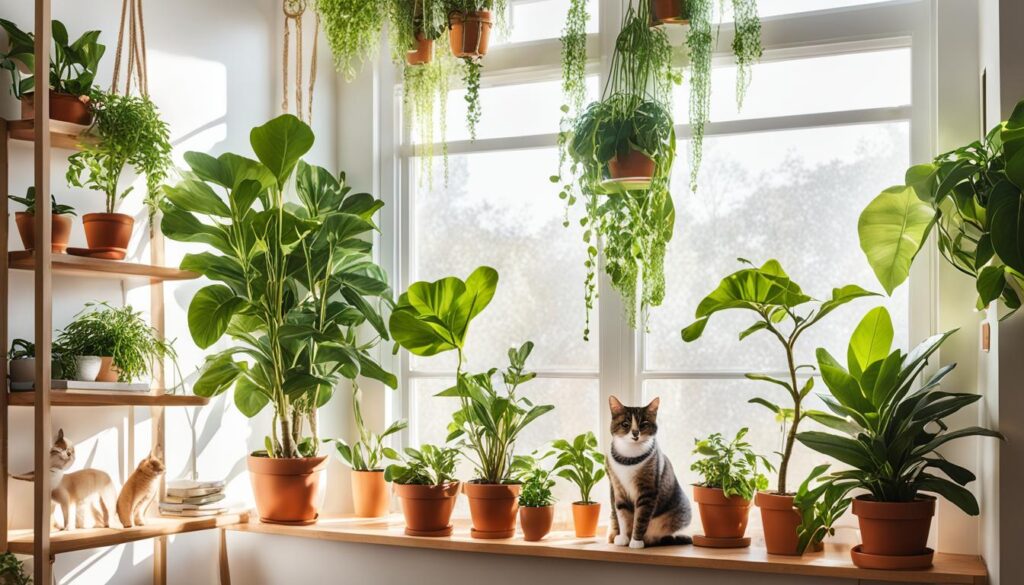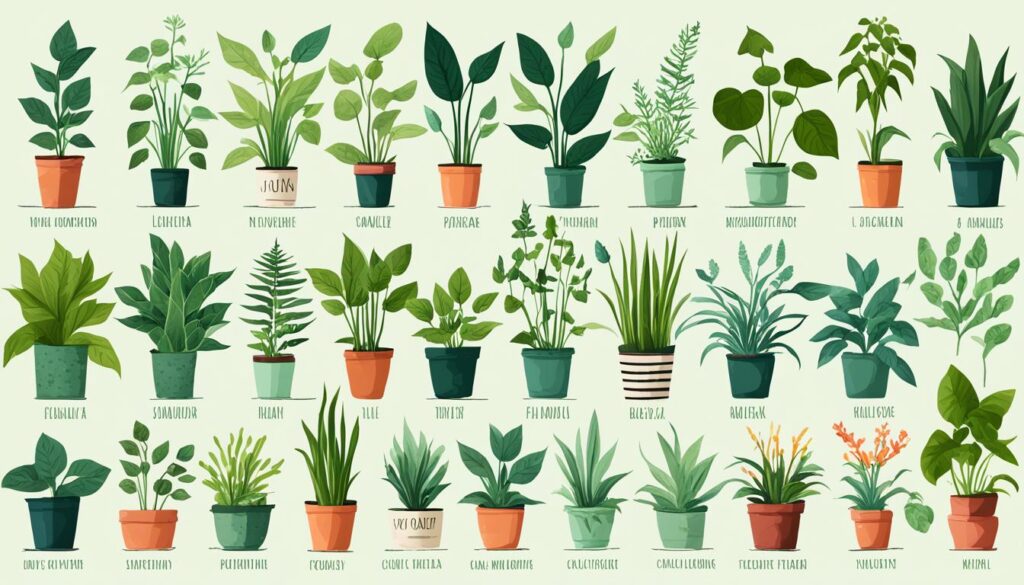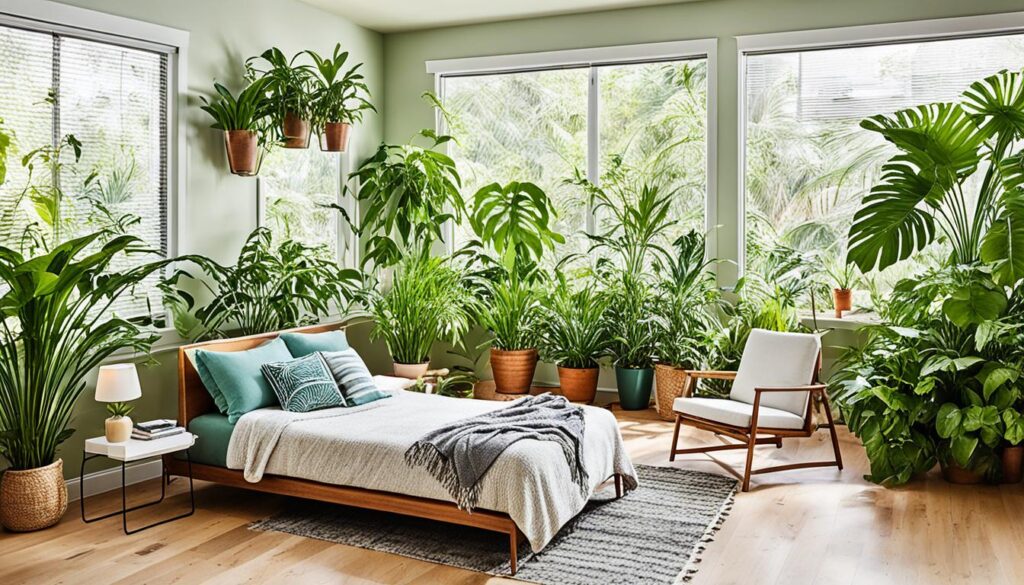Ever thought about making your home green without putting your pet at risk? Adding non-toxic houseplants can make your space a cozy retreat for you and your pets. With pet-safe indoor plants, you can boost air quality, cut down stress, and give your pets something to look at and think about. This guide will show you the best plants for a safe, pet-friendly garden at home.
Key Takeaways
- Choosing non-toxic houseplants ensures a safe environment for pets.
- Pet-safe indoor plants can improve air quality and reduce stress for pets.
- Popular pet-friendly houseplants include Spider Plants, Boston Ferns, and Areca Palms.
- Proper placement and care are essential for maintaining a pet-friendly indoor garden.
- Engaging with pet-friendly plant communities can provide valuable tips and experiences.
Benefits of Pet-Safe Houseplants for Your Home
Adding pet-safe houseplants to your home makes it look better and is good for your health and your pets’. These plants help make your home a better place in many ways.
Improved Air Quality
Many pet-safe houseplants clean the air naturally. The Spider Plant, for example, removes toxins like formaldehyde and carbon monoxide from the air. This makes the air inside your home healthier. Plants like Parlor Palms and Areca Palms also help clean the air and are safe for pets.
Stress Reduction for Pets
Greenery in your home can make it more relaxing for pets. Studies show that pets with plants have less anxiety. Plants like Moss Amigos moss balls and Parlor Palms are easy to care for and love indirect sunlight and moderate water.
Visual Stimulation and Mental Engagement
Houseplants keep pets busy and engaged. They love looking at and smelling plants. Spider Plants and Boston Ferns are great for pets because they are safe and fun to watch.
Natural Hideouts for Pets
Pet-safe houseplants create perfect spots for pets to hide and feel safe. Plants like Calathea have leaves that pets find interesting. These spots are great for shy or anxious pets.
Toxin Absorption
Many houseplants take toxins out of the air, making your home healthier. Spider Plants are good at removing pollutants like formaldehyde and benzene. Adding these plants means a safer home for you and your pets.
Top Choices for Pet-Friendly Houseplants
Choosing houseplants that are safe for pets is easy with the right options. These plants are not only beautiful but also safe for animals. They let pets explore and enjoy their space safely.
Spider Plant (Chlorophytum comosum)
The Spider Plant is great for cleaning the air and is safe for pets. It’s a favorite among pet owners for its air-purifying qualities. It’s easy to care for and has lively green leaves that brighten any room.
Boston Fern (Nephrolepis exaltata)
The Boston Fern looks great and loves humid places. It’s safe for dogs and cats. It helps improve air quality and makes indoor spaces feel lush and green.
Areca Palm (Dypsis lutescens)
The Areca Palm is known for its beauty and cleaning the air. It’s safe for pets. This plant is a top pick for those wanting beauty and safety in their homes.
Money Tree (Pachira aquatica)
The Money Tree is a great choice for pet owners. It’s seen as a symbol of good luck and is safe for pets. It adds greenery and a touch of luck to any room.
Calathea (Calathea spp.)
Calathea plants have beautiful leaves and are safe for animals. They add natural beauty to homes and are a secure choice for pet owners.
These houseplants create a safe and fun space for pets. They look great and help make indoor spaces healthy and peaceful.
Pet-Safe Houseplants: Creating a Green Haven without Risking Your Pet’s Health
It’s important for pet owners to pick safe indoor plants to keep their pets healthy. Choosing plants that won’t harm pets if they eat them is key. This way, pet owners can enjoy the beauty and clean air of houseplants safely.
Spider Plants are great because they clean the air, removing toxins like formaldehyde. This helps pets and people live healthier together.
Boston Ferns are safe for cats and clean the air too. They’re perfect for homes that want to be pet-safe and green.
Bamboo Palms add a tropical look without being a risk to pets. They clean the air, making homes safe and beautiful for pets.
Money Trees and White Orchids are pretty and safe for cats. They bring good luck and beauty to any room.
Cat Grass is great for pets who like to nibble on plants. It helps with digestion and stops hairballs, giving pets important nutrients.
Air Plants don’t need soil and are safe for pets. They’re unique and add an interesting touch to pet-safe gardens.
But, some plants like lilies are very bad for cats and can make them very sick. It’s important to know which plants are safe and avoid the dangerous ones.
| Plant | Benefit | Safety |
|---|---|---|
| Spider Plant | Air-purifying | Safe for pets |
| Boston Fern | Air-purifying | Non-toxic to cats |
| Bamboo Palm | Filters toxins | Safe for pets |
| Money Tree | Good luck symbol | Safe for cats |
| White Orchid | Visual appeal | Non-toxic to pets |
| Cat Grass | Aids digestion | Grown for pet consumption |
| Air Plants | Unique display options | Safe for pets |
Understanding how pets and indoor plants interact is crucial. Using resources like the ASPCA’s list can help owners pick safe plants. This way, pets and plants can live together happily and safely.
How to Choose Pet-Safe Houseplants
Choosing non-toxic indoor plants is key for pet owners who want a safe green space at home. It’s important to do your homework and pick carefully. This guide will help you pick safe houseplants for your pets.
Checking Plant Toxicity
First, make sure to check if a plant is safe for pets. The ASPCA, Animal Emergency Service, and VCA Animal Hospitals have lists of risky plants. For example, lilies and sago palms are bad, but spider plants and Boston ferns are safe.
Researching Pet-Safe Plant Lists
You can fill your home with plants without risking your pets’ health. Spider plants, Boston ferns, and areca palms are good choices. Look up lists of safe plants to make smart picks.
Understanding Plant Labels and Warnings
Always read the labels when picking houseplants. They tell you about any dangers. Plants like calatheas do well in certain conditions, like low light and high humidity.
Consulting with Experts
If you’re unsure, get advice from experts. Vets and nursery staff can help with safe plant choices. They can guide you to the best non-toxic plants for your home.
| Plant | Pet-Safety | Care Tips |
|---|---|---|
| Spider Plant (Chlorophytum comosum) | Non-toxic | Thrives in indirect light |
| Boston Fern (Nephrolepis exaltata) | Non-toxic | Prefers moist, shaded conditions |
| Areca Palm (Dypsis lutescens) | Non-toxic | Needs bright, indirect light |
| Bamboo Palm (Chamaedorea seifrizii) | Non-toxic | Thrives in low light |
| Calathea (Calathea spp.) | Non-toxic | Prefers low to medium light with high humidity |
Proper Placement and Care for Pet-Friendly Indoor Plants
Having pet-friendly indoor plants in your home is great for both you and your pets. Here are some tips to keep your plants and pets happy and safe together.
Using Elevated Planters
Elevated planters are a smart choice for pet safety. They keep plants away from pets that might try to eat them. Plus, they make your indoor garden look nice with different heights.
Securing Pots to Prevent Accidents
Make sure your houseplants are securely placed to avoid accidents. Use anchors or weights to keep pots steady. This stops pets from knocking them over and causing messes.
Avoiding Tempting Plant Fronds
Some plants have long fronds that pets might find fun to play with. Choose plants with shorter leaves to keep your pets safe. This way, you can enjoy your plants without worrying about your pets.
Following Appropriate Watering Routines
Water your plants safely to keep them and your pets healthy. Don’t let water sit around, as it can attract mosquitoes. Right watering keeps your plants and pets safe from pests.
Opting for Pet-Safe Pest Control
When fighting pests, pick safe options for your pets. Use natural repellents that won’t harm your pets. This way, you can keep your plants pest-free without risking your pet’s health.
Common Toxic Plants to Avoid
It’s important to know which plants are toxic to pets to keep them safe. Many homes have plants that are harmful to our pets. In 2020, over 10,000 cats and dogs went to the vet because they ate houseplants.
Here are some plants you should avoid to protect your pets:
- Lilies: All parts of the lily are poisonous to cats. Even a little bit can cause kidney failure.
- Oleander: Dogs can get very sick from eating oleander. They may have diarrhea, a fast heart rate, feel sleepy, have seizures, or even pass out.
- Philodendron: This plant is common but can make pets sick. They might drool, feel nauseous, and vomit.
- Tulip Bulbs: Tulips have chemicals that can upset a pet’s stomach. They may feel sad, eat less, and get very sick.
- Lily of the Valley: This plant is very dangerous for cats and dogs. All parts of it can hurt them.
Avoiding these plants can greatly lower the chance of your pet getting poisoned. For example, lilies are pretty but can kill cats. Tulips are bright but can make pets very sick. Knowing which plants are safe is key to keeping pets safe at home.
Here’s a list of some toxic and safe plants for pets:
| Plant Type | Toxic Plants | Pet-Safe Alternatives |
|---|---|---|
| Flowers | Foxgloves, Oleander, Tulip bulbs, Bluebells | African Violet, Bromeliads, Gerbera Daisy, Zinnia |
| Houseplants | Philodendron, Lily of the Valley | Spider Plant, Boston Fern, Parlor Palm |
| Outdoor Plants | Rhododendron, Autumn Crocus | Black Hawthorn, Magnolia Bush |
To keep your home safe for pets, always check out new plants before you bring them in. Use trusted sources like Epic Gardening for advice. This way, you can stop health emergencies and keep your pets and plants happy together.
Engaging with Pet-Friendly Plant Communities
For those interested in pet-friendly houseplants, joining online forums and local gardening groups is a great step. These communities let pet owners share tips and learn from others. They offer new ideas, help solve problems, and support creating safe spaces with plants.
Online Forums and Local Groups
Getting involved with pet-friendly gardening groups and online forums for pet-safe plants broadens your knowledge and connects you with others. Sites like GardenWeb or Reddit’s Plant Clinic are perfect for sharing pet-safe plants and advice. Local groups also host events for learning and making friends.
Sharing Experiences and Tips
Being in these groups lets members share their gardening stories and advice. You can learn about pet-friendly gardening solutions or get warnings about dangerous plants. Tips on keeping pets safe, like pest control and barriers, are often shared.
Learning from Fellow Pet and Plant Enthusiasts
Members of pet and plant communities know a lot from their own experiences and research. By joining, you get to learn from their knowledge. You can ask about plants, keeping pets away, and caring for plants safely. This helps avoid mistakes and keep your home safe and green for pets.
Creating a Harmonious Environment with Pets and Plants
Keeping a peaceful home means making sure pets and plants live together well. When you bring new plants home, watch your pets closely. This stops them from hurting themselves or the plants.
Supervising Pets Around New Plants
Pets are naturally curious. Watching them closely when you add new plants is key. It helps avoid accidents or them eating plants that could be harmful.
Early Training for Pets
Teaching pets about houseplants early on is smart. It helps them learn to live with plants peacefully. Using positive methods like treats can work well.
Providing Alternative Diversions
Give pets something else to do instead of bothering your plants. Toys and scratching posts are great options. They keep your pets busy and away from your plants.
Regular Vet Check-ups
Seeing the vet regularly is important for your pet’s health around plants. It helps catch any health problems early. A local vet can give advice that fits your pet’s needs.
By following these steps, you can make a happy space for pets and plants together. Both can enjoy their home without harming each other.
| Plant Type | Potential Toxicity | Symptoms in Dogs |
|---|---|---|
| Lilies | High | Vomiting, lethargy, fatal kidney failure |
| Azaleas | Moderate | Vomiting, drooling, cardiac arrest |
| Sago Palm | Severe | Liver damage, death, vomiting, diarrhea, seizures |
| Philodendrons | Moderate | Gastrointestinal issues, vomiting, diarrhea |
| Pothos | Moderate | Gastrointestinal issues, vomiting, diarrhea |
Choose safe plants like spider plants and Boston ferns. They make your home look good and keep your pets safe and healthy.
The Benefits of a Safe, Green Haven for Pets
Creating a safe space for pets means adding safe and beneficial houseplants. These plants make homes safe and enjoyable for pets and their owners.
Many pet-friendly plants, like Moss Amigos moss balls, are safe for curious pets. The Spider Plant is also safe if pets eat it. The Parlor Palm is another good choice for a pet-safe home.
About half of indoor plants are safe for pets. They help make the home healthier by taking in carbon dioxide and giving out oxygen. Plants like snake plants and peace lilies clean the air of toxins.
Studies show that indoor plants can lower stress and anxiety in dogs. Plants like lavender and chamomile help improve pets’ moods. Adding these plants to pet areas can make pets happier.
Some plants can also reduce allergens. Spider plants and aloe vera can cut down on allergens in the air. This helps pets and people with allergies.
Placing plants carefully is key to getting the most benefits. Setting up special areas for pets to play and relax is important. This way, pets and plants can both do well together.
| Pet-Safe Plant | Benefits |
|---|---|
| Moss Amigos moss balls | 100% safe, no risk if nibbled |
| Spider Plant | Non-toxic, safe even if ingested |
| Parlor Palm | Non-toxic, safe for all pets |
| Lavender | Stress and anxiety reduction |
| Chamomile | Mood-enhancing properties |
| Snake Plant | Filters household toxins |
| Aloe Vera | Reduces allergens |
By choosing and placing pet-safe plants carefully, pet owners can make a safe and green space. This not only makes the home look better but also helps pets and owners feel better.
Conclusion
As we wrap up our look at pet-safe houseplants, it’s clear that they offer more than just beauty. They help your pets’ mental, physical, and emotional health while making your home look great. By picking safe plants like Spider Plant and Boston Fern, pets can move around safely.
Choosing the right pet-friendly plants and placing them correctly is key. This way, you can love plants and keep your pets safe. Plants like Snake Plant and peace lilies clean the air. Others, like lavender and chamomile, help reduce stress and anxiety in pets.
Creating a green space for pets means always putting their health first. Watch them around new plants and get advice when needed. Keep them busy with other things to avoid trouble. A mix of plants and careful pet care makes a safe haven for everyone.
The journey of adding pet-safe plants is rewarding and good for everyone. It creates a caring space for pets and people alike.


